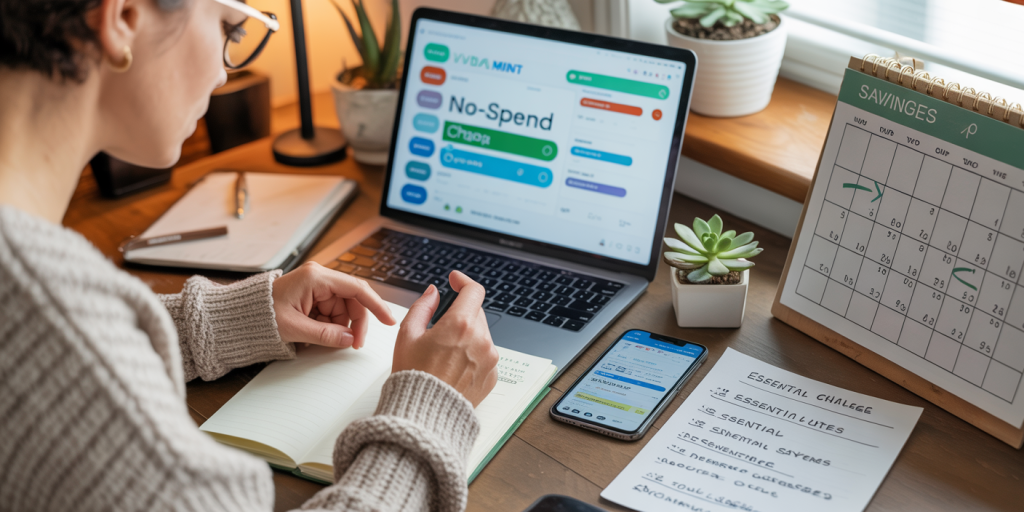In an era where consumerism dominates daily life, managing personal finances has become increasingly essential. One effective method gaining popularity among budget enthusiasts and financial advisors alike is the No-Spend Challenge. This challenge encourages participants to halt non-essential spending for a defined period, fostering financial discipline and mindfulness. Whether seeking to save for a specific goal or break impulsive spending habits, the No-Spend Challenge offers a practical approach to money management.
This article will guide you through understanding, implementing, and navigating the No-Spend Challenge, supported by statistics, practical examples, and comparative insights. By exploring this financial tactic, you can enhance your savings, reshape spending habits, and create a healthier relationship with money.
Understanding the No-Spend Challenge: What It Entails and Who It Benefits
The No-Spend Challenge is a personal finance initiative where individuals commit to avoiding all non-essential purchases for a certain timeframe, typically ranging from a few days to several months. Essential expenses such as rent, utilities, groceries, and debt payments are usually exempt, while discretionary spending on dining out, entertainment, clothing, and impulse buys is paused.
This challenge is particularly beneficial for people facing financial stress, trying to recover from debt, or building an emergency fund. For instance, a 2021 survey by Bankrate revealed that 28% of Americans struggle with unexpected expenses, highlighting the importance of saving and budgeting measures like the No-Spend Challenge. By eliminating discretionary expenses, participants redirect funds toward savings or debt reduction.

Multiple demographic groups have embraced this challenge—from college students aiming to curb lifestyle inflation to retired individuals wanting to maintain financial stability. The flexibility of the No-Spend Challenge’s duration and scope allows it to be a personalized tool for diverse financial situations.
How to Successfully Plan and Execute a No-Spend Challenge
Planning is crucial to maintaining the challenge and maximizing its benefits. Start by defining your goals—are you aiming to save $500, reduce credit card debt, or simply reset your spending habits? A clear goal provides motivation and focus.
Next, identify your essential vs. non-essential expenses by reviewing your last three months of bank statements. Make a list of allowed expenditures, covering necessities such as groceries, medication, rent, utility bills, and fuel for work commuting. Any purchase beyond this list is temporarily off-limits.
Creating a budget plan helps allocate funds for essentials during the challenge. Also, consider stockpiling household necessities before the challenge begins; this minimizes the temptation to make unplanned purchases. For example, buying non-perishable goods or household items in advance can prevent unnecessary trips to stores later.
Using apps such as Mint or YNAB (You Need a Budget) to track expenses during the challenge can increase accountability. Moreover, informing friends and family about your commitment can help reduce social pressure to spend.
Example: A real-life case involved Jane, a freelancer in New York, who committed to a 30-day No-Spend Challenge in 2023. By restricting dining out and luxury purchases, she saved $600, which she directed toward debt repayment. Jane also noticed an improvement in her impulse control and an increased appreciation for her existing belongings.
Common Challenges During the No-Spend Challenge and How to Overcome Them
Despite the apparent simplicity, participants often encounter obstacles that test their resolve. Social situations present a major challenge, especially when friends or colleagues invite you out, pushing you toward spending money.
To overcome this, substitute paid activities with free or low-cost alternatives. Instead of a night out at a restaurant, try hosting a potluck or organizing a free local event like community sports or park gatherings. Utilizing such options maintains social engagement without compromising your financial discipline.

Another frequent difficulty is the temptation to justify small spending, often called “snacking” on expenses—like buying a coffee daily or an occasional app. These small amounts add up and can undermine the challenge’s purpose.
Tracking every expense, no matter how minor, reinforces awareness and helps curb these hidden leaks in your budget. According to a 2022 study by the National Endowment for Financial Education, individuals who tracked all spending saved an average of 15% more during budgeting challenges compared to those who did not.
Benefits Beyond Savings: Psychological and Lifestyle Changes from the No-Spend Challenge
While the immediate advantage of the No-Spend Challenge is clear—enhanced savings—the benefits extend beyond financial gains. Many participants report a shift in mindset, focusing more on needs versus wants. This minimalist approach encourages sustainable living by reducing waste and valuing experiences over possessions.
For example, a participant named Michael documented his 60-day challenge experience, noting reductions in stress related to financial uncertainty and an improved overall sense of control. Psychological benefits include reduced anxiety and enhanced self-esteem as individuals witness their ability to control spending impulses.
Moreover, changing spending habits often inspires lifestyle adjustments such as cooking at home, repairing old items, or upcycling furniture. These behaviors promote creativity and environmental consciousness, aligning with increasing global concerns about sustainability.

Comparative Analysis: No-Spend Challenge vs. Other Budgeting Methods
To understand the relative effectiveness of the No-Spend Challenge, it’s helpful to compare it with other popular budgeting strategies like the 50/30/20 rule and envelope budgeting.
| Feature | No-Spend Challenge | 50/30/20 Rule | Envelope Budgeting |
|---|---|---|---|
| Duration | Usually short-term (1 day to several months) | Ongoing, monthly | Ongoing, monthly |
| Flexibility | Strict during challenge; looser after | Moderate flexibility in categories | Rigid, defined spending limits |
| Psychological Impact | Strong discipline and mindfulness practice | Balanced budget prioritization | Physical control of cash spending |
| Ease of Implementation | Requires commitment and planning | Relatively simple; percentage based | Requires cash management skills |
| Savings Potential | Often high in short term | Moderate, ongoing moderate savings | Variable; depends on adherence |
| Ideal for | Resetting habits, emergency savings | Long-term balanced budgeting | Hands-on budgeters preferring tangible cash control |
The No-Spend Challenge’s short-term intensity offers a quick boost in savings and habit realignment, making it appealing for those needing immediate financial relief or a behavioral reset. However, for sustained money management, integrating long-term budgeting methods like the 50/30/20 rule may offer more systematic control.
What to Expect After Completing the No-Spend Challenge
Post-challenge, participants often face an important crossroads regarding their financial habits and future spending. Many experience a heightened awareness of their consumption patterns, which can influence lasting change.
Some individuals need to transition back to regular spending gradually, to avoid a “rebound effect” of overspending due to pent-up desires during the challenge. Creating a modified budget that incorporates some of the insights gained can prevent relapse into impulsive spending.
Success stories often emphasize the importance of reflection; journaling or reviewing financial progress can solidify lessons learned. For example, a survey conducted by NerdWallet in 2023 found that 63% of individuals who completed a No-Spend Challenge felt more confident about managing their money afterward.
Future Perspectives: The No-Spend Challenge in an Evolving Financial Landscape
As technology and consumer behaviors evolve, so do the methods to manage personal finance, including the No-Spend Challenge. The rise of mobile payment systems, subscription services, and online shopping creates both opportunities and challenges for participants.
Looking ahead, the integration of artificial intelligence tools in financial management promises to tailor challenges even more precisely to individual habits and goals. For instance, AI-powered apps may soon suggest personalized no-spend days or identify spending categories ripe for cutting based on real-time data.
Additionally, growing awareness of financial wellness and mental health benefits connected to spending behavior is likely to enhance the popularity of challenges like these. In the post-pandemic world, where household savings rates increased from 7.5% in 2019 to 13.6% in 2020 according to the U.S. Bureau of Economic Analysis, embracing such challenges can support continued financial resilience.
Overall, the No-Spend Challenge will likely remain a versatile, adaptive, and valuable strategy for individuals seeking control over their financial futures while cultivating mindful, intentional consumption habits.
Engaging in a No-Spend Challenge can be transformative, offering a tangible path toward stronger financial health and improved lifestyle choices. With proper planning, realistic goal setting, and supportive tools, anyone can benefit from this simple yet powerful financial exercise.

Deixe um comentário